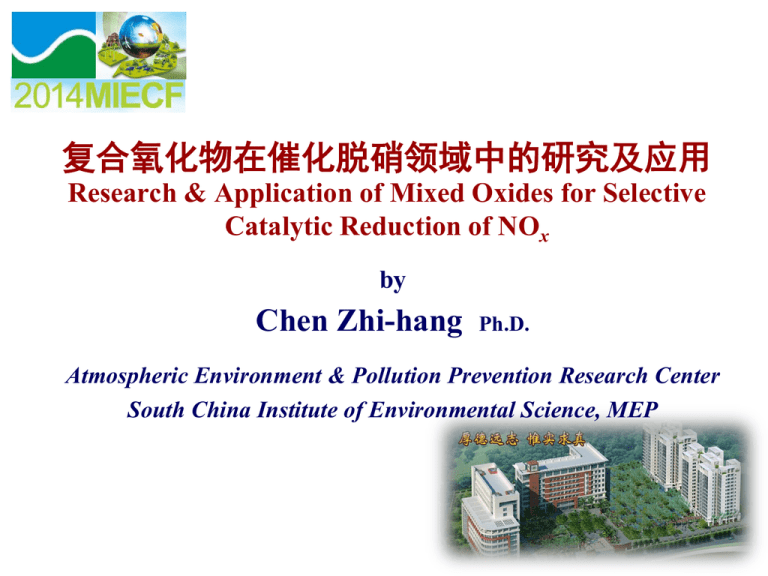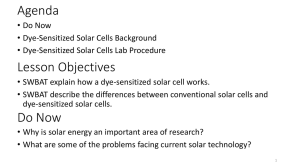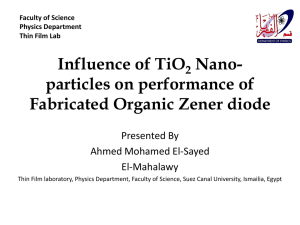MnO x
advertisement

复合氧化物在催化脱硝领域中的研究及应用 Research & Application of Mixed Oxides for Selective Catalytic Reduction of NOx by Chen Zhi-hang Ph.D. Atmospheric Environment & Pollution Prevention Research Center South China Institute of Environmental Science, MEP Contents SCIES Introduction Mixed-oxide Catalysts for Industrial Boiler at High Temperature Mixed-oxide Catalysts for SCR at Low Temperature Mixed-oxide Catalysts for Glass Kilns at Middle-low Temperature Conclusions & Prospect Introduction SCIES 49% Beijing 5% NOx emission Transportation Power Plant Others 46% Frequency Area% Nitrogen oxide emissions from Shanghai power plants, industrial boilers, and kilns accounted for 70% in China. (Journal of Environmental Sciences, 2008, 28(12): 2470-2479) Guangzhou <5% 5~10% 10~25% 25~50% 50~75% >75% No data Acid Rain Distribution in China 67.4% 6.8% 10.4% 8.2% 5.4% 1.8% Technology for DeNOx Adsorption Method SCIES SNCR NH3-SCR Commercialized High efficient NH3 Plasma Method SCR DeNOx SCR Reaction: 4 NO 4 NH 3 O2 4 N 2 6 H 2O Microbial Process G 298 1627kJ / mol Electrolytic Process SCR——selective catalytic reduction SNCR——selective Non catalytic reduction SCIES Mixed-oxide Catalysts for Industrial Boiler at High Temperature SCR for flue gas denitrification in power plant boilers Honeycomb Corrugated plate SCR DeNOx Reactor in power plant boilers. SCIES Flat SCR V2O5-WO3(MoO3)/TiO2 The process flow diagram of SCR denitrification in power plant boilers. Flue gas denitrification pilot test ——Small and medium-sized boiler SCIES The honeycomb SCR catalyst developed by Tsinghua University et. al. Test device for flue gas denitrification(200 Nm3/h) National High Technology Research and Development Program of China (2006) Guangdong-Hongkong Project of The Major Breakthroughs in Key Areas (2008) Demonstration projects of SCR ——Industrial boiler SCIES SCR DeNOx Reactor Demonstration projects of SCR denitrification (35 t/h chain-grate boiler in Pacific(Panyu) Textiles Limited, flow rate: 70000 Nm3/h ) SCR Denitrification tower of Pacific co. SCIES Mixed-oxide Catalysts for SCR at Low Temperature SCR at Low Temperature SCIES SCR SCR at 80~150℃ Energytemperature efficient andfor cost saving Suitable catalysis(SCR at 350~450℃) Typical hasAs low activity under low temperature Dust (e.g., SCR K2O,catalyst CaO, and 2O3) and SO2 deactivate the catalyst Novel Catalyst should be developed for low temperature Catalysts Developed for Low-Temperature SCR[1~12] SCIES MnOx、MnOx/TiO2、CuOx-MnOx and MnOx-CeO2 etc.. Mn-Cu/TiO2、Mn-Cr/TiO2 catalysts showed good activity (CNO: 60%, 120oC, NO/NH3 =1 at 0.2%, GHSV=8,000 h-1) MnOx-CeO2 exhibited well activity(100oC, CNO:~90%, NO/NH3 =1 at 0.2%,GHSV=42,000 h-1) Sulfur dioxide and vapour resistant are weak. Mixed-oxide catalyst may be a kind of prospective lowtemperature SCR candidates [1] Catal. Commun. 8 (2007) 2096. [2] Appl. Catal. A 327 (2007) 261. [3] Catal. Commun. 8 (2007) 329. [4] Appl. Catal. B 79 (2008) 347. [5] Catal. Commun. 8 (2007) 1896. [6] Angew. Chem. Int. Ed. 40 (2001) 2479. [7] Appl. Catal. B 44 (2003) 217. [8] Catal. Today 111 (2006) 236. [9] Appl. Catal. B 51 (2004) 93. [10] Appl. Catal. B 62 (2006) 265. [11] Chem. Commun. 7 (2003) 848. [12] Ind. & Eng. Chem. Res. 45 (2006) 6444 Screen of Low-temperature SCR Catalysts 100 SCIES 100 Ni(0.5)-CoOx(SR)(600) Zr(0.5)-CrOx(SR)(600) 80 Co(0.5)-CrOx(SR)(600) 60 NOx conversion (%) NOx conversion (%) 80 Fe(0.5)-CoOx(SR)(600) 40 20 0 100 125 150 175 o Temperature ( C) 200 60 Sr(0.5)-MnOx(SR)(600) 40 Co(0.5)-MnOx(SR)(600) Ni(0.5)-MnOx(SR)(600) 20 0 100 Cr(0.5)-MnOx(SR)(600) Fe(0.5)-MnOx(SR)(600) 125 150 175 200 o Temperature ( C) Activity of mixed oxides prepared by SR method Activity evaluation conditions:[NO]=[NH3]=1000 ppm[,O2]=3%,[SO2]=100 ppm,GHSV=30,000 h-1 Cr-MnOx、Fe-MnOx are potential catalysts Cr-MnOx SCR activity at Low temperature 100 New crystal ▼ 60 40 CrOx ▼ ▼ ▼ ▼ ▼ ◇ ◇ ◇ ▲ ◇ ◇ ▲ ◇▲ ▲▲ ▲▲ ▲ ◇ ▽ ▽ ▽ ▽ ▽▽ ▽ ▽ ▽ ▽ ▽ ▽▽ ▽ MnOx 20 ▲Cr2O3 ◇Mn2O3 d ▼ ◇ Intensity (a.u.) NOx conversion (%) 80 ▼CrMn1.5O4 ▽Mn3O4 ▼ ▼ SCIES ▲ ▲ ▲ CrOx-MnOx Cr(0.5)-MnOx c b ▽ ▽ ▲ ▲ ▲ ▲ ▲ 40 50 ▲ a ▲ ▲ ▲ ▲▲ ▲▲ 0 80 100 120 140 160 180 o Temperature ( C) 200 220 10 20 30 60 o 2( ) SCR activity and XRD patterns of (a) CrOx; (b) MnOx; (c) CrOx-MnOx; (d) Cr(0.5)-MnOx catalysts 70 80 ▼ CrMn1.5O4 ▽ Mn3O4 ◆ MnO ▼ Cr(0.5)-MnOx ▼ SCIES ▼ Cr(0.4)-MnOx ▼ ▼ ▼ ▼ ▼ Cr(0.3)-MnOx ◆ Cr(0.3)-MnOx Cr(0.2)-MnOx Cr(0.2)-MnOx ▽ ◆ ◆ Cr(0.1)-MnOx ▽ ▽ 10 20 ▽ ▽ 30 ▽ 40 ▽ ◆ ▽▽ ▽ ▽ ▽▽ 50 60 ◆ Intensity (a.u.) ▼ Cr(0.4)-MnOx ◆ ▽ ▽ 70 80 2 XRD patterns and SEM images of the Cr-MnOx catalysts doped by different Cr content Cr(0.1)-MnOx Mechanism studying ——Cr-MnOx Structure analysis SCIES MnO Cr2O3 CrMn1.5O4 Bond length of crystals Crystal Mn3O4 MnO Cr2O3 CrMn1.5O4 Mn3O4 Oxygen bridge between Cr and Bond Bond-length Mn-O 2.2922Å Mn in the form of Cr-O-Mn; Mn-O 1.9475Å Mn-O 2.0142Å Cr-O bond in CrMn1.5O4 is Mn-O 2.2215Å Cr-O 2.0367Å Cr-O 1.9458Å Mn-O 2.3509Å Cr-O 1.4686Å shorter than those of CrOx Cell of CrMn1.5O4 Mn-O bond in CrMn1.5O4 is longer than those of MnOx Mechanism studying ——Cr-MnOx Raman spectra measurement SCIES Raman Cr(0.5)-MnOx shift of CrOx in lower wave number without presenting in mixed oxides conforms the formation of new phase; Cr(0.4)-MnOx Cr(0.3)-MnOx New Raman shift appears and increases with the increasing of Cr content; Cr(0.2)-MnOx Cr(0.1)-MnOx Mn3O4[16-18] Cr2O3[13-15] MnOx CrOx 200 300 400 500 600 700 800 900 -1 Raman shift (cm ) Raman spectra of catalysts Raman shift at 539.3 and 642.7cm-1 are the characteristic shifts of Cr-O-Mn in CrMn1.5O4 [13] J. Appl. Phys. 99 (2006) 053909; [14] Mater. Sci. Eng. B 118 (2005) 74; [15] J. Appl. Phys. 103 (2008) 023507; [16] J. Electrochem. Soc. 140 (1993) 3065; [17] J. Mater. Chem. 11 (2001) 1269; [18] J. Catal. 150 (1994) 94 Mechanism studying ——Cr-MnOx XPS measurement 2+ Mn 2+ Cr Cr3+ (A) Cr c 4+ Cr 2p - b 2- OH /CO3 c Intensity (a.u.) Intensity (a.u.) (C) 5+ Mn b O 1s 2- O (B) regenerated c Intensity (a.u.) Mn 2p 3+ Mn SCIES used b a fresh a a 640 645 650 655 Binding Energy (eV) 660 570 575 580 585 590 Binding Energy (eV) 595 525 530 535 540 Binding Energy (eV) XPS spectra for (A) Mn 2p, (B) Cr 2p, and (C) O 1s of the Cr(0.4)-MnOx catalysts: (a) fresh catalyst, (b) used catalyst, (c) regenerated catalyst. Mechanism studying ——Cr-MnOx XPS measurement Binding energies (eV) of core electrons of Cr(0.4)-MnOx catalysts* XPS spectra Cr 2p (eV) Concn(%) Mn 2p (eV) Concn(%) O 1s (eV) Concn(%) Element valence Used Regenerat ed Cr2+ 575.6(13.9) 575.7(16.8) 575.7(19.7) Cr3+ 576.7(42.2) 576.7(49.9) 576.6(38.0) Cr5+ 578.4(43.9) 578.3 (33.3) 578.5(42.3) Mn2+ 640.4(14.6) 640.5(15.5) 640.5(16.0) Mn3+ 641.9(54.2) 641.9(46.9) 642.2(60.6) Mn4+ 644.6(31.2) 644.5(37.6) 644.8(23.4) O2- 529.8(71.0) 529.8(73.9) 529.9(72.2) 531.6(29.0 531.7(26.1) 531.8(27.8) 3 2- * Surface concentration of different Mn, Cr and O states are in parenthesis Regenerated catalyst Cr(0.4)-MnOx Catalysts Fresh OH/CO After 500h SCR SCIES Cr5+ 10.6% Mn3+ 7.3% Cr3+ 7.7% Mn4+ 6.4% Cr5+ Normal pressure & temperature plasma treatment 9.0% Mn3+ 13.7% Cr3+ 11.9% Mn4+ 14.2% Mechanism studying ——mechanism elucidation SCIES 2 O-ads O2 NO Mn4 NOads Mn3 2Mn3+ 2Mn4+ Redox CrMn1.5O4 Electronic transfer Cr5+ Reaction Cr3+ 2 NO2 O2 Cr 3 Cr 5 2Oads NOads Oads NO2 Cr 5 2Mn3 Cr 3 2Mn4 2 NO 2 NO+ads Redox catalytic cycles over Cr(0.4)-MnOx catalysts Journal of Catalysis, 2010, 276: 56-65. Industrial & Engineering Chemistry Research, 2012, 51: 202-212. Industrial & Engineering Chemistry Research, 2014, 53: 2647–2655. Pilot test of Low-temperature SCR The Low-temperature SCR catalyst developed by Research Center for Eco-environmental Science, CAS et. al. National Natural Science Foundation of China(2008) National High Technology Research and Development Program of China (2009) SCIES Test device for Lowtemperature SCR (Circulating fluidized bed boiler in Guangzhou Huiteng Textiles Limited, flow rate: 5000 Nm3/h ) SCIES Mixed-oxide Catalysts for Glass Kilns at Middle-low Temperature Middle-low temperature SCR for glass kilns SCIES Middle-low temperature SCR Work at 180~300℃ High activity Strong ability of sulfur tolerant The flue gas emission from glass kiln of China South Glass Group(Guangzhou) (The concentration of SO2、NOx is very high(about 500~3000mg/m3) The temperature of flue gas is low(< 280℃) The process flow diagram of SCR for glass kiln. Screen of Middle-low Temperature SCR Catalysts SCIES 100 90 NOx conversion (%) 80 70 2V8Co/TiO2(F) 60 2V8Fe/TiO2(F) 50 2V8Ni/TiO2(F) 40 2V8Cu/TiO2(F) 30 2V8Mn/TiO2(F) 20 3V7Mn/TiO2(F) 3V7Fe/TiO2(F) 10 3V7Cu/TiO2(F) 0 200 225 250 275 300 325 o Temperature ( C) SCR activity of VM/TiO2 catalysts 350 Effect of SO2 SCIES 100 90 NOx conversion (%) 80 70 2V8Co/TiO2(F) 60 2V8Fe/TiO2(F) 50 2V8Ni/TiO2(F) 40 2V8Cu/TiO2(F) 30 2V8Mn/TiO2(F) 20 3V7Mn/TiO2(F) 3V7Fe/TiO2(F) 10 3V7Cu/TiO2(F) 0 1h 2h 3h 4h Time (h) Effects of SO2 on NOx conversions over VM/TiO2 catalysts at 275oC. Reaction conditions: [NO]=[NH3]=1000 ppm, [O2]=3%, [SO2]=600 ppm, GHSV=60,000 h-1 XPS measurement SCIES 2V20Cu/TiO2 V4+ 2V16Cu/TiO2 2V12Cu/TiO2 V5+ 2V8Cu/TiO2 2V2Cu/TiO2 VCuMn/TiO2 & VCoMn/TiO2 Catalysts SCIES VCoMn/TiO2 VCuMn/TiO2 100 100 90 80 70 60 50 2V1Cu9Mn/TiO2(F) 40 2V2Cu8Mn/TiO2(F) 30 2V3Cu7Mn/TiO2(F) 20 2V5Cu5Mn/TiO2(F) 10 NOx conversion (%) NOx conversion (%) 80 2V1Co9Mn/TiO2(F) 2V2Co8Mn/TiO2(F) 60 2V3Co7Mn/TiO2(F) 2V4Co6Mn/TiO2(F) 2V5Co5Mn/TiO2(F) 40 2V6Co4Mn/TiO2(F) 2V7Co3Mn/TiO2(F) 20 2V8Co2Mn/TiO2(F) 2V8Cu2Mn/TiO2(F) 0 200 225 250 275 300 o Temperature ( C) 325 350 2V9Co1Mn/TiO2(F) 0 200 225 250 275 300 o Temperature ( C) SCR activity of VCuMn/TiO2 & VCoMn/TiO2 Catalysts 325 350 Effect of SO2 SCIES VCoMn/TiO2 100 100 80 80 60 2V1Cu9Mn/TiO2(F) 40 2V2Cu8Mn/TiO2(F) 2V3Cu7Mn/TiO2(F) 20 2V5Cu5Mn/TiO2(F) NOx conversion (%) NOx conversion (%) VCuMn/TiO2 2V1Co9Mn/TiO2(F) 2V2Co8Mn/TiO2(F) 60 2V3Co7Mn/TiO2(F) 2V4Co6Mn/TiO2(F) 2V5Co5Mn/TiO2(F) 40 2V6Co4Mn/TiO2(F) 2V7Co3Mn/TiO2(F) 20 2V8Co2Mn/TiO2(F) 2V8Cu2Mn/TiO2(F) 0 2V9Co1Mn/TiO2(F) 0 1 2 3 Time (h) 4 1 2 3 4 Time (h) Effects of SO2 on NOx conversions over VCuMn/TiO2 & VCoMn/TiO2 catalysts at 250oC. Reaction conditions: [NO]=[NH3]=1000 ppm, [O2]=3%, [SO2]=600 ppm, GHSV=60,000 h-1. Advanced Materials Research, 2012, 550-553: 128-131. Journal of Fuel Chemistry and Technology, 2012, 40(4):469-474. Forming of Catalysts The vacuum refining mud machine SCIES Hydraulic extruder Natural Science Foundation of Guangdong (2011) National Natural Science Foundation of China (2013) Conclusion & Prospect SCIES Localization of Commercial SCR catalyst has been made progress. How to reduce the cost of catalyst, establish of catalyst regeneration center. Novel Cr-MnOx, Fe-MnOx, Mn-Zr catalysts with well low-temperature SCR activity have been developed; If we can not solve the problem of high activity at low temperature( < 120 ℃ ) , should we change our thinking. Series of VMn, VCu, and modified catalysts are studying systematically. How to improve the activity of the catalyst under high concentration of SO2 is a huge challenge. Acknowlegment Ministry of Environmental Protection, China Ministry of Science Technology, China National Natural Science Foundation of China Natural Science Foundation of Guangdong, China Department of science and technology of Guangdong Province Department of science and information technology of Guangzhou South China University of Technology Thank you for your attention!





